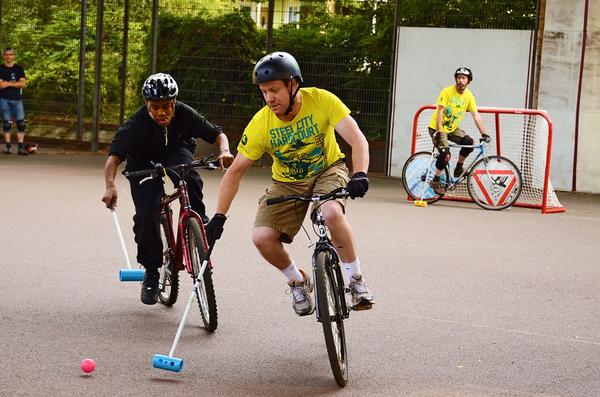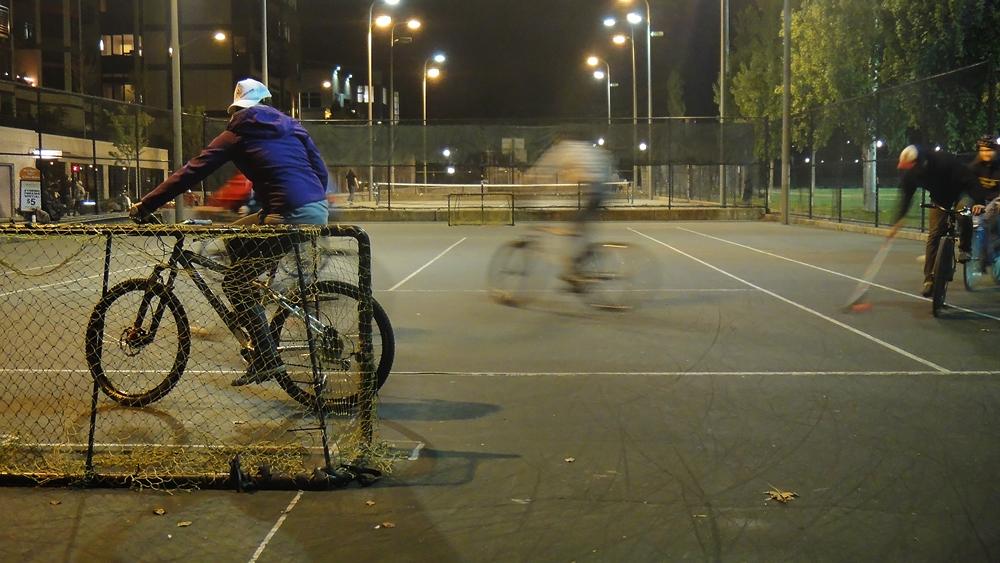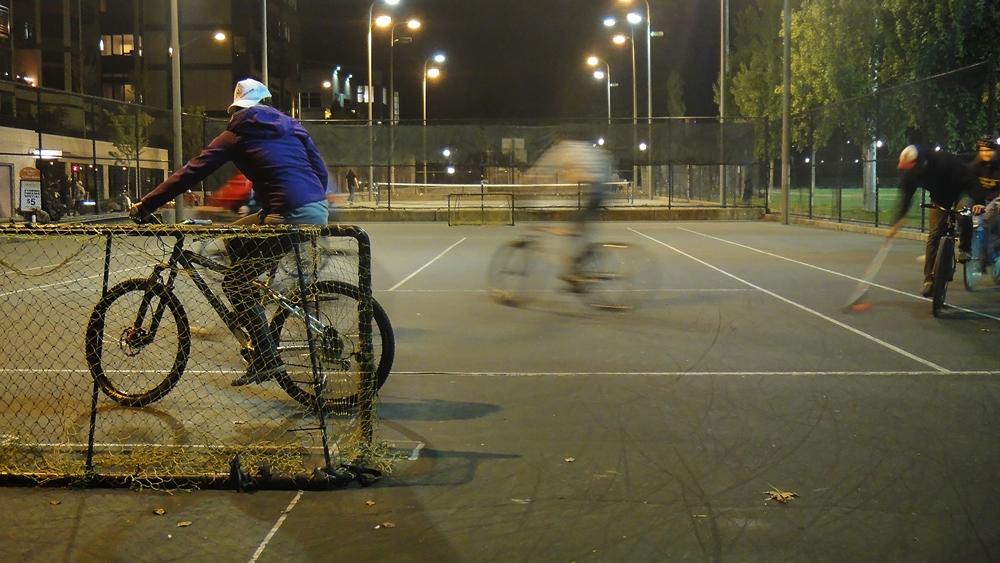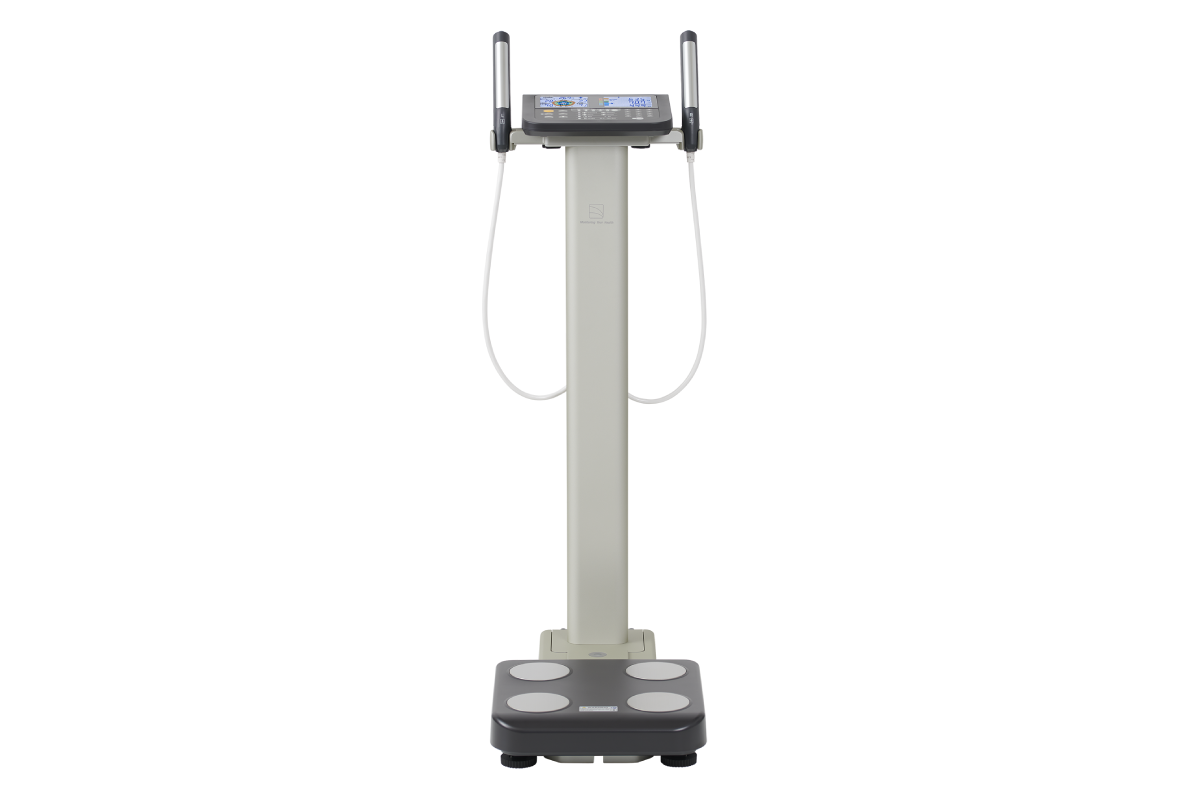Bike Polo
A new sport is taking urban areas by storm. Hardcourt bike polo is a fast, exciting game which is attracting people from all backgrounds. Leisure centres are already taking notice and some have added the rapidly growing sport to their activities

Bike polo is a direct descendant of the ancient game of polo, which according to historians dates back to 600BC. Played on horseback, the “original” polo was a fierce and aggressive game played between herdsmen in dusty outbacks – a sport unrecognisable to those familiar with the modern, gentrified version played on manicured greens in front of sponsored marquees and champagne-sipping crowds.
Subsequently, despite the lack of an equine element, Bike Polo has much more in common with its fervid ancestor than modern day polo. It’s a fast-paced, gritty, full contact sport played by people of all backgrounds. Starting out is easy – all you need is a bike and a mallet, (most of the mallets are home made). As a result, it is attracting players of all background and ages – making it a fast growing sport with a bright future.
How it started
Although hardcourt bike polo – the most recent, urbanised version of the sport – is a fairly recent activity, bicycle polo itself has a long and distinguished history. Invented in 1891 by Irish cycling enthusiast Richard J Mecredy, it became widely popular in the UK. The Bicycle Polo Association of Great Britain (BPA) was founded in 1897 and the sport also crossed the Atlantic that same year, when the first bike polo club launched in the US. At the height of its early popularity, bike polo was played internationally and featured at the 1908 London Olympic Games.
The game grew steadily and by 1938 BPA of Great Britain had 170 teams in 100 clubs with 1,000+ players. Following World War II, however, the sport suffered and its popularity rapidly decreased. During the post-war years bicycle polo became a marginal sport and remained so for decades – until in 1994 it suddenly re-emerged in the US.
The first hardcourt polo games – played by bicycle couriers in their free time – were contested in Seattle in 1999 and from there the sport spread rapidly across US cities. After taking over the West Coast the sport finally reached New York in 2004.
After the first games in New York, it was only a matter of time before the sport would return to its ancestral home. The first hardcourt games in London took place in 2006 and the first European championships were held in London in 2009. In the same year, the London Hard Court Bike Polo Association (LHBPA) was formed as part of plans to better organise the fledgling sport and its capital-based clubs. By 2012 the sport had spread to every corner of the UK and at the latest count there were nearly 100 teams playing regularly in the UK.
Getting Organised
Despite the increasing number of clubs and players, there is no official national governing body as yet. Last year, the LHBPA teamed up with similar regional associations in Birmingham, Brighton, Manchester and elsewhere to form the United Kingdom Hardcourt Bike Polo Association (UKHBPA). While UKHBPA has been tasked with leading the lobbying on behalf of the sport, it is very much in its infancy and has yet to be recognised by Sport England. In the absence of an official NGB, LHBPA and other regional associations have picked up the baton and are working to increase participation numbers and to make the sport more recognised in their areas. Currently LHBPA’s main projects include a range of outreach programmes, as well as the organising of the annual London Open competition. The London Open event is now in its fourth year and has grown into the largest international tournament for bike polo – in 2012 it attracted 82 clubs from 16 countries.
Meanwhile, LHBPA’s successful outreach programme with schools has seen bike polo introduced in PE lessons and after-hours cycling clubs across a number of London boroughs. Figures show that there are now more than 500 school children playing the sport within the Greater London area.
According to LHBPA chair Jess Duffy, the association encourages, supports and develops participation in the sport in a range of ways. “One of our main roles is to develop access to suitable playing areas and provision of training facilities,” she says. “One of the methods we use is to lobby local councils and other appropriate bodies for access to and provision of suitable playing areas. We are also helping in the redevelopment of the courts that are used by hardcourt bike polo players in London.”
Recently, the LHBPA produced a courts proposal that has been sent to councils and property owners. The proposal outlines how courts and play areas can be designed with bike polo in mind and it’s hoped it will lead to more suitable spaces being created for the sport.
The association has also been researching new forms of “pop-up” courts which can be used for exhibitions and events. Duffy says that financial constraints make it difficult at times to get new projects off the ground.
“The problem is that the regional associations and organisations are run entirely by volunteers, so there’s only so much we can do. As we aren’t yet recognised by Sport England, we get no financial help towards our projects and have to fund everything ourselves or look for sponsors.
“In other countries – such as Germany and France – the government is really backing hardcourt polo. In France, for example, purpose-built courts are being built for the sport.”
This lack of funding is currently threatening one of LHBPA’s flagship projects – it plans to establish bike polo courts in the middle of the historic Herne Hill velodrome. “The concrete has been poured and we’re nearly there,” says Duffy. “But we still need another £16,000 to finish it off and establish a fence around the courts to make it playable – it’s very frustrating.”
Get Involved
While London remains the main hub for hardcourt bike polo in the UK, there are a number of active clubs around the country from Aberdeen to Plymouth. However, the lack of a national structure makes it hard for clubs to stay in touch with each other to organise games – and for regional associations to gauge the exact size of the sport in their locale.
“It is becoming increasingly difficult to accurately report on UK polo as a whole,” says Duffy. “For example, it’s impossible to even begin to estimate the exact number of players in the country. Just this week I received an entry to this year’s London Open from a club in Grantham in Lincolnshire – we weren’t even aware that there were games being organised in that part of the country! It’s obvious that there are people out there setting up clubs after seeing clips of bike polo being played on youTube.”
As interest in the sport grows, Duffy hopes more councils and leisure centres with MUGAs and other suitable surfaces will make their facilities available for games. The regional associations are keen to organise open days, during which qualified coaches will be on hand to introduce the sport to people. Duffy encourages facilities to get in touch with a local club or association, because all a leisure centre needs to provide is a space.
“The sessions are completely free to set up and most associations will even provide the bikes if needed,” Duffy says, and adds that a big part of the attraction of bike polo is down to the social aspect. “The bike polo scene is like a big family. Once you start playing, you quickly make friends. The games themselves – while competitive – are played in a friendly, relaxed atmosphere.”
RULES
Teams are made up of three players and to score you have to use the end of your mallet. Any contact between players has to be like-for-like – mallet to mallet, bike to bike, body to body. Players are not allowed to put their feet on the ground - if they do, they are required to “tap out” at the side of the court before being allowed back into the game. The first team to reach five points wins, or if the time runs out, the team with most goals when the whistle blows wins.
WE’RE DOING IT
Westway Sports Centre in North Kensington, London, is one of the leisure centres that has added bike polo to its offering. The centre started running weekly open sessions in March 2012. They take place each Thursday and are hosted by Bikeminded, an organisation which encourages people to cycle in the Royal Borough of Kensington and Chelsea.
The sport is attracting a following and interested players need no equipment, as the centre rents bikes and provides mallets and balls.
Kathryn Evans, director of operations at Westway, says: “With Olympic legacy plans in full swing, this is a great time to be harnessing the enthusiasm around cycling. Bike polo is fast, exhilarating and fun to play. We’ve been able to forge some strong community links through the sport and it’s fantastic to see that this little-known sport is making a strong comeback.”
WHAT YOU NEED TO PLAY
The minimum size for a playing area is 15m x 35m. The court has to be flat and on a surface on which the ball moves in a predictable manner. Walled or solid sides need to be erected so players can ride along without risking injury. According to LHBPA recommendations, floodlights should also be available to allow games to be played during winter evenings.
Each player will need a bike and a mallet. While you can play polo on any bike, most regular players have purpose-built cycles or at least heavily modified ones. Low gearing, strong wheels that resist impact, wheel covers that stop spokes being damaged and a short wheelbase to allow tight cornering are all recommended. Powerful brakes are also useful, as are thick tyres that last longer on court.
Nearly all mallets are home-made using golf clubs or ski poles as shafts and a length of utility pipe for a head. There is an easy-to-follow guide on making mallets available from the LHBPA.



Membership Manager
Membership Manager
Recreation Assistant
Duty Manager (Dry)
Swim Teacher
Swim Teacher
Chief Executive Officer, Mount Batten Centre
Swim Teacher
Swimming Teacher
Swimming Teacher
Company profile

Featured Supplier

Property & Tenders
Company: Knight Frank
Company: Belvoir Castle
Company: AVISON YOUNG
Company: London Borough of Bexley
Company: Forestry England















